Every basketball program has its legends. The point guard who led the team to three consecutive championships. The center who dominated the paint and set rebounding records that stood for decades. The sharpshooter who drained the game-winning three-pointer in overtime of the state finals. These moments and achievements define programs, inspire future athletes, and create traditions that bind communities together.
Yet many schools struggle to give basketball records the recognition they deserve. Traditional trophy cases overflow with aging plaques. Physical record boards become outdated the moment new records fall. Static wall displays force impossible decisions about which achievements merit limited space. And passive recognition approaches fail to engage digitally native students who expect interactive, multimedia-rich experiences that tell complete stories.
This comprehensive guide explores how modern recognition technology solves these challenges while transforming basketball records from forgotten statistics into inspiring narratives that motivate excellence, strengthen program culture, and build lasting community pride. Whether launching new recognition programs or modernizing existing displays, understanding contemporary approaches to basketball records recognition enables schools to honor achievement effectively while creating strategic value extending far beyond simple acknowledgment.
Why Basketball Records Recognition Matters
Basketball records recognition serves purposes extending well beyond displaying names and numbers on walls. Comprehensive recognition programs deliver tangible benefits for athletes, programs, and communities.
Motivating Current Athletes Through Visible Excellence
Visible recognition of basketball records provides concrete targets that motivate athletes to pursue excellence. When players see records displayed prominently, they understand exactly what achievement looks like at their institution and gain specific goals to work toward.
According to research published in the Journal of Sport Psychology, athletes who have clear, visible performance benchmarks demonstrate 34% higher motivation levels compared to those without concrete achievement targets. Basketball records recognition transforms abstract concepts of excellence into specific, measurable goals.
Motivational Impact:
- Clear Performance Standards: Displayed records establish specific benchmarks athletes can understand and pursue
- Pathway Visibility: Seeing teammates’ and predecessors’ achievements demonstrates that excellence is attainable
- Recognition Aspiration: Knowledge that achievements will be publicly celebrated motivates athletes to reach record-worthy performance
- Healthy Competition: Visible records create positive competitive drive as athletes strive to join the recognized elite
- Personal Investment: Understanding that contributions will be permanently documented increases athlete commitment

Building and Sustaining Program Tradition
Successful basketball programs cultivate rich traditions connecting current teams to decades of institutional history. Records recognition serves as the foundation for tradition building by preserving achievement and creating continuity across generations.
Tradition Development Benefits:
- Current players understand they’re part of something larger than single seasons
- Alumni see their achievements preserved and valued decades later
- Recruits recognize programs with deep traditions and sustained excellence
- Communities celebrate institutional identity rooted in historical success
- Program values and standards remain consistent across coaching changes
- Success expectations pass from generation to generation naturally
Schools implementing comprehensive basketball record boards discover that preserved history becomes self-reinforcing—each recognized generation feels increased responsibility to maintain standards set by predecessors, creating momentum toward sustained program excellence.
Strengthening Community Pride and Engagement
Basketball programs serve as focal points for school and community identity. Records recognition amplifies this role by creating visible evidence of program excellence that community members celebrate and share.
Research from the National Federation of State High School Associations indicates that schools with comprehensive athletic recognition programs experience 42% higher game attendance and 37% stronger booster club participation compared to schools with minimal recognition.
Community Impact:
- Shared Identity: Celebrated achievements become part of collective community identity
- Conversation Starters: Recognition displays create natural talking points during games, tours, and community events
- Multi-Generational Connection: Alumni reconnect with programs by seeing their achievements preserved alongside current records
- Social Sharing: Modern digital displays enable content sharing that extends recognition reach beyond physical locations
- Donor Engagement: Visible recognition of program excellence motivates community investment in continued success

Enhanced Recruitment and Program Marketing
Comprehensive basketball records recognition provides competitive advantages during athlete recruitment by demonstrating program excellence, player development commitment, and achievement culture that prospective athletes seek.
Recruitment Benefits:
- Prospective athletes visiting facilities see immediate evidence of program success
- Records demonstrate development pathways from freshman participation to record-breaking achievement
- Modern recognition systems convey innovation and forward-thinking program culture
- Families evaluate program commitment to honoring athlete contributions
- Historical depth indicates sustained excellence rather than momentary success
- Digital displays showcase multimedia content including video highlights and athlete testimonials
Athletic directors consistently report that recognition displays become highlighted features during recruiting tours, with prospects and families photographing displays and commenting positively about visible achievement celebration.
Types of Basketball Records Worth Recognizing
Comprehensive basketball records recognition extends beyond simply displaying scoring statistics. Effective programs celebrate diverse achievement types reflecting the multifaceted nature of basketball excellence.
Individual Scoring Milestones
Scoring achievements represent basketball’s most visible individual accomplishments and naturally attract attention from players, families, and communities.
Career Scoring Recognition:
- 1,000 point scorers with comprehensive career profiles
- 1,500 and 2,000 point milestone achievers for exceptional careers
- All-time leading scorers with historical context
- Points per game career averages for different eras
- Single-season scoring leaders across program history
- Single-game scoring performances (30+ point games, 40+ point games, 50+ point games)
Scoring Excellence by Position:
- Top guard scorers demonstrating perimeter excellence
- Leading post players showing dominance inside
- Balanced scorers who excel from multiple areas
- Three-point specialists and shooting records
- Free throw percentage and consistency records
Many schools create special recognition for the exclusive 1,000 point club, as discussed in comprehensive guides about celebrating significant basketball milestones and inspiring future achievement.

Complete Statistical Excellence
Basketball offers rich statistical categories beyond scoring that deserve equal recognition for demonstrating complete player excellence.
Rebounding Records:
- Career rebounding leaders showing commitment to controlling boards
- Single-season rebounding totals
- Single-game rebounding performances
- Offensive rebounding specialists
- Defensive rebounding consistency
- Rebounds per game averages
Assist and Playmaking Records:
- Career assist leaders demonstrating playmaking excellence
- Single-season assist totals
- Single-game assist performances
- Assist-to-turnover ratio leaders
- Pure point guards who prioritize team play
Defensive Excellence:
- Career steals leaders showing defensive intensity
- Career blocks leaders protecting the rim
- Single-season defensive achievements
- Deflections and defensive plays (when tracked)
- Defensive player awards and recognition
All-Around Excellence:
- Triple-double achievements (points, rebounds, assists)
- Double-double consistency
- Complete statistical performers across categories
- Efficiency ratings and advanced metrics
- Plus-minus leaders showing team impact
Team Achievement Records
Team accomplishments represent collective excellence and should receive prominent recognition alongside individual achievements.
Team Records to Display:
- Season Performance: Total wins, winning percentages, undefeated seasons, playoff appearances
- Championships: Conference titles, regional championships, state titles across program history
- Scoring Records: Most points in season, highest scoring average, largest victory margins
- Defensive Excellence: Fewest points allowed, best defensive efficiency, shutout quarters or halves
- Streak Records: Consecutive wins, home game winning streaks, rivalry game dominance
- Tournament Success: State tournament appearances, final four runs, championship game appearances
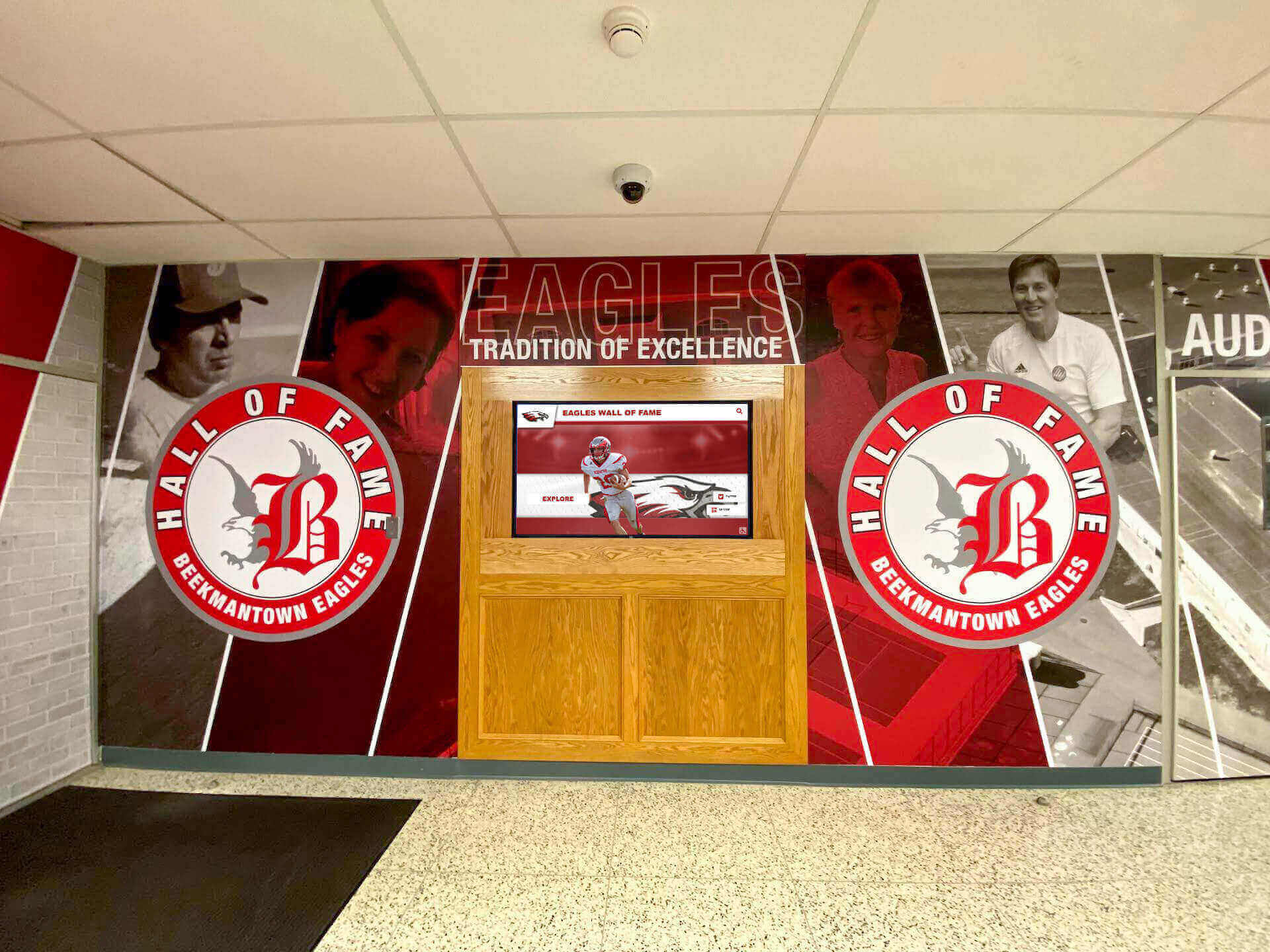
Academic and Character Recognition
Comprehensive recognition programs celebrate achievements beyond on-court statistics, demonstrating that program excellence encompasses complete student-athlete development.
Off-Court Recognition:
- Academic All-American selections
- Team cumulative GPA leaders
- Scholar-athlete awards
- Community service hours and impact
- Leadership awards and team captain recognition
- Sportsmanship awards
- Character recognition from coaches and peers
- Perfect attendance records
- Multi-sport athlete achievements
This holistic approach communicates that programs value complete development rather than athletic performance alone.
Special Achievements and Milestones
Unique achievements that demonstrate exceptional moments or sustained excellence deserve special recognition.
Special Recognition Categories:
- Consecutive games scoring in double figures
- Consecutive free throws made
- Perfect shooting games (100% field goal percentage)
- Buzzer-beaters and game-winning shots
- Comeback victories led by individual performances
- Records against rival schools
- Tournament MVP awards
- All-conference and all-state selections
- College commitments and scholarship achievements
- Professional career achievements for program alumni
Traditional Basketball Records Recognition Approaches
Understanding traditional recognition methods provides context for evaluating contemporary alternatives and identifying limitations driving modernization.
Physical Record Boards and Vinyl Lettering
Traditional record boards typically consist of painted or vinyl lettering applied directly to gymnasium or hallway walls, listing records by category with athlete names, years, and performance statistics.
Advantages of Traditional Boards:
- Permanent physical presence creating visible program celebration
- No ongoing technology costs or software licensing
- Simple implementation requiring only design and installation
- Familiar format easily understood by all audiences
- Can be aesthetically pleasing with proper design
Significant Limitations:
- Update Complexity: Changing records requires professional vinyl application, paint matching, or complete board replacement—time-consuming and expensive processes
- Space Constraints: Fixed physical space limits how many records can be displayed, forcing difficult prioritization decisions
- Static Presentation: Basic text and numbers with no multimedia content, photographs, or video
- Inflexibility: Reorganizing or restructuring displays requires complete reinstallation
- Accessibility Issues: Wall-mounted displays at specific heights may not be easily viewable by all visitors
- Deterioration: Physical materials fade, peel, and degrade over time, requiring costly refurbishment
According to facility managers surveyed across 200 high schools, traditional record board updates average $150-300 per record change when accounting for materials, labor, and administrative coordination.
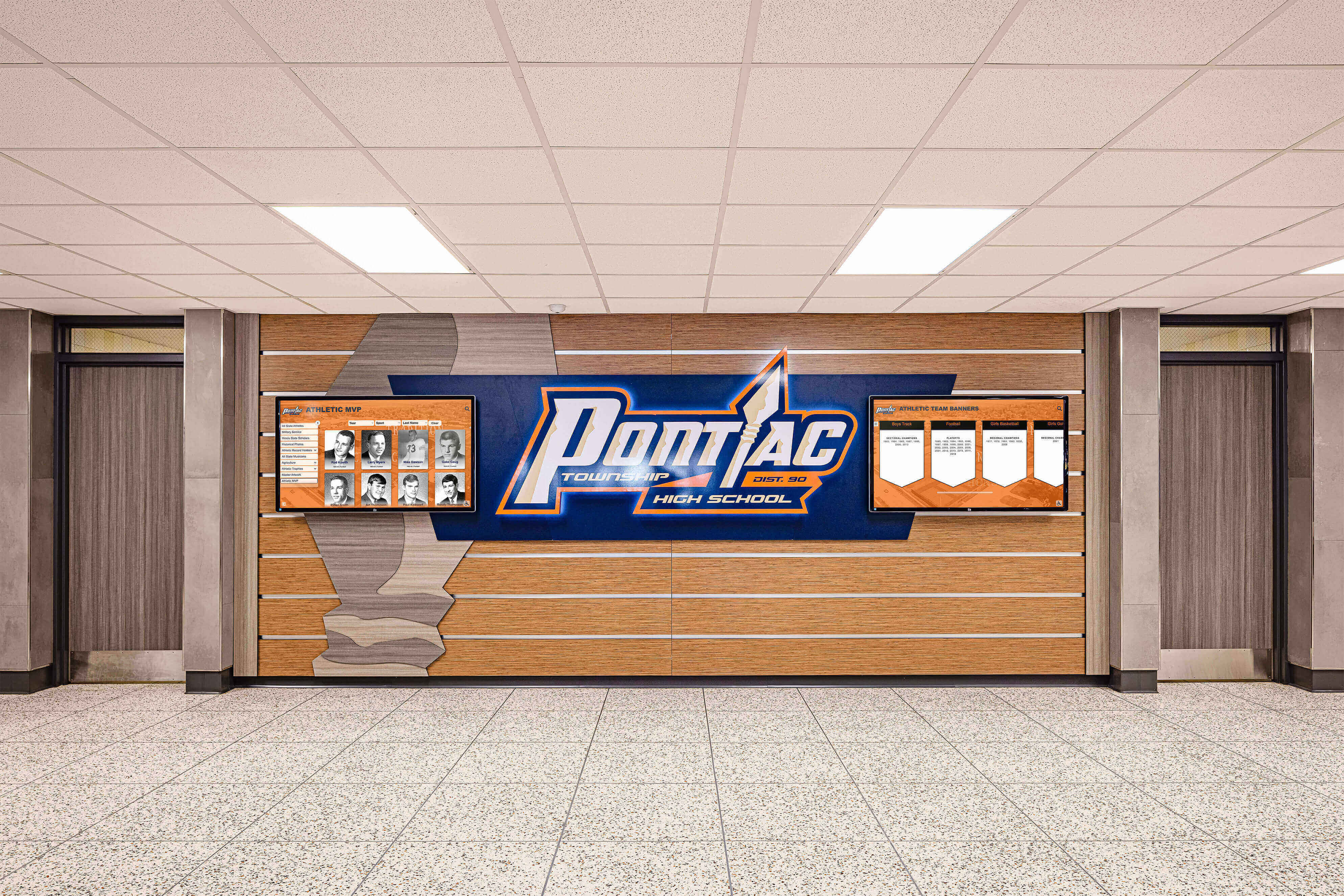
Trophy Cases and Physical Displays
Trophy cases displaying physical awards, game balls, championship hardware, and memorabilia provide tangible connections to achievements. These displays work well for major team accomplishments but face capacity constraints as programs accumulate trophies across decades.
Trophy Case Challenges:
- Limited physical space forces removal of older trophies as new ones accumulate
- Display depth limitations mean items in back rows become difficult to see
- No context beyond basic labels—visitors can’t access detailed achievement stories
- Security concerns about valuable memorabilia
- Maintenance requirements for cleaning and preservation
- Inflexible organization that’s difficult to modify
- Dust accumulation and deterioration over time
- Lighting challenges affecting visibility
Many schools discover that significant trophies and memorabilia end up in storage rather than displayed because physical cases reach capacity. This unfortunate situation means achievements remain unrecognized despite deserving celebration.
Plaques and Wall-Mounted Recognition
Individual plaques mounted on dedicated walls represent another common recognition approach, typically featuring engraved athlete names, years, achievements, and sometimes photographs.
Plaque System Limitations:
- Expensive per-inductee costs ($75-200 per plaque) multiplied across many athletes
- Wall space consumption limits total recognition capacity
- Difficult to maintain consistent formatting as plaque styles change over decades
- Updates require physical installation labor
- Limited biographical information fits on fixed-size plaques
- No ability to search, filter, or explore relationships between athletes
- Name spellings and statistics errors require complete plaque replacement
- Mounting hardware failures over time
Modern Digital Basketball Records Recognition Solutions
Digital recognition technology eliminates traditional approach limitations while introducing capabilities that transform how schools celebrate basketball excellence.
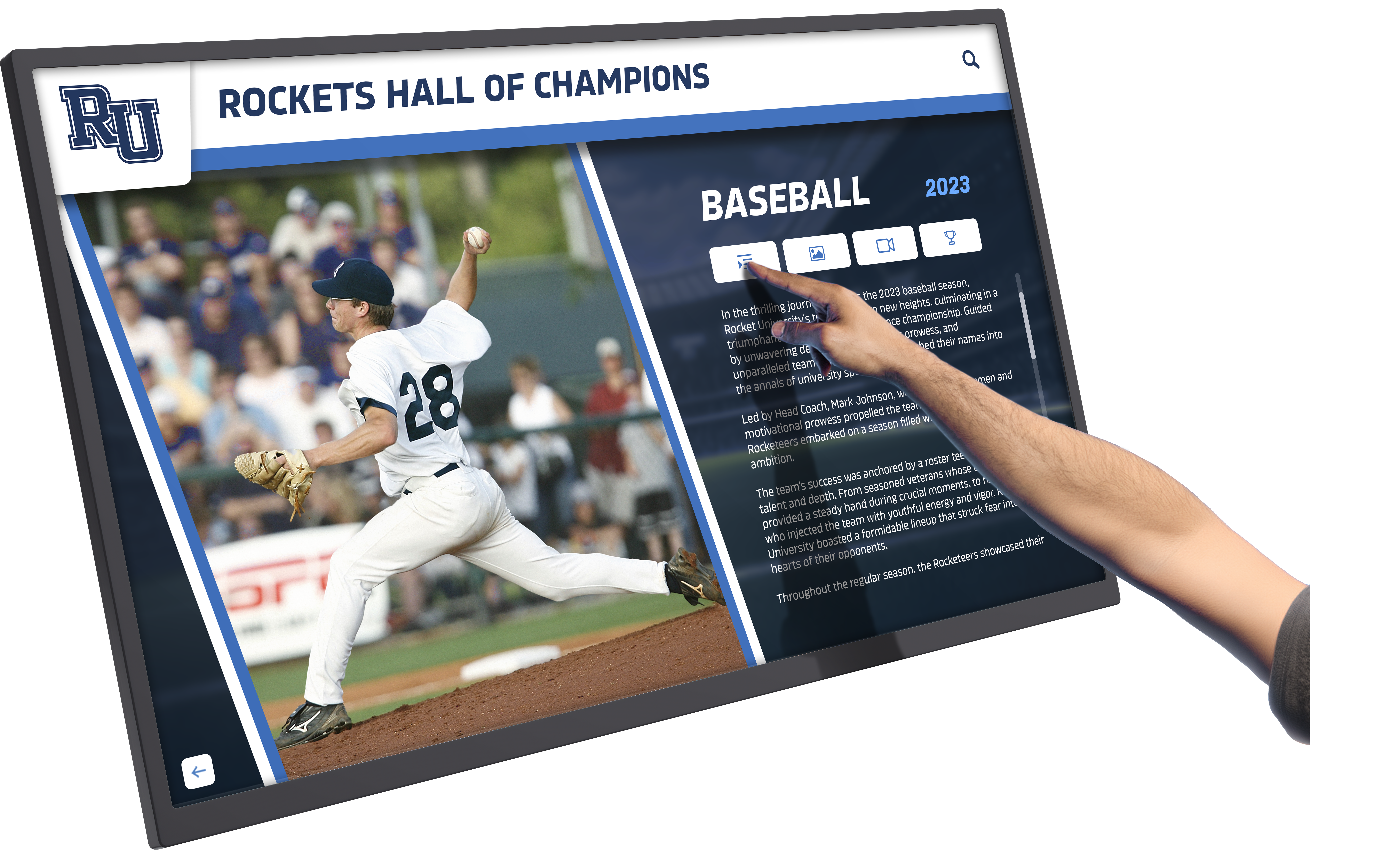
Interactive Touchscreen Displays
Digital touchscreen systems provide the foundation for comprehensive basketball records recognition, combining commercial-grade hardware with sophisticated software enabling rich content and intuitive interaction.
Digital Display Components:
Hardware Elements:
- Commercial-grade touchscreen displays (43" to 98" depending on space and viewing distance)
- Industrial computing modules providing reliability and performance
- Wall-mounted or freestanding kiosk configurations
- High-resolution panels (1080p or 4K) ensuring crisp text and image quality
- Multi-touch responsive interfaces supporting natural gesture control
- Professional mounting systems securing displays safely
- Tempered glass surfaces resistant to damage
Software Capabilities:
- Cloud-based content management systems enabling remote updates from any device
- Intuitive touchscreen interfaces requiring no instructions for visitor use
- Searchable databases allowing instant athlete or record lookup
- Filtering by position, year, achievement type, or keyword
- Multimedia integration supporting photos, videos, and extended narratives
- Automatic content rotation featuring different records and athletes
- Analytics tracking engagement patterns and popular content
- Mobile-responsive web versions extending access beyond physical displays
Solutions like Rocket Alumni Solutions provide purpose-built platforms specifically designed for athletic recognition, offering turnkey functionality addressing unique needs of sports achievement celebration.
Unlimited Recognition Capacity
Perhaps the most transformative advantage of digital systems: unlimited capacity for recognizing achievements without space constraints forcing difficult prioritization decisions.
Capacity Benefits:
- Recognize every record across all categories without omitting achievements due to space limitations
- Document complete program history from founding through present day
- Add new categories as desired without physical display modification
- Provide equal visibility for all athletes rather than featuring only recent or major records
- Include comprehensive statistics, biographical information, and achievement context
- Preserve legacy content while continuously adding new recognition
- Showcase both men’s and women’s basketball programs comprehensively
- Include junior varsity and freshman records when appropriate
Schools transitioning from traditional to digital recognition consistently discover they had far more achievement worthy of celebration than physical space allowed them to display. Digital systems ensure comprehensive recognition honoring every deserving athlete and milestone.

Rich Multimedia Storytelling
Digital platforms enable recognition depth impossible with traditional static displays, transforming simple record listings into compelling achievement stories that engage viewers emotionally and intellectually.
Multimedia Content Types:
Photography:
- Professional athlete portraits and action photography
- Game-day moments capturing record-breaking performances
- Team celebration photos commemorating championships
- Historical images connecting past and present program eras
- Before-and-after athlete development progressions
- Senior night and special ceremony moments
Video Content:
- Game highlight footage showing record-breaking performances
- Athlete testimonials reflecting on their achievements and experiences
- Coach commentary providing context about achievements and athlete development
- Championship game footage preserving memorable seasons
- Alumni update videos showing life after basketball
- Documentary-style features about program history
Extended Narratives:
- Comprehensive athlete biographies beyond basic statistics
- Achievement context explaining circumstances of record-breaking performances
- Obstacle stories documenting challenges overcome
- Team culture descriptions showing how programs developed excellence
- Alumni success stories connecting basketball to life achievements
- Quotes from coaches, teammates, and family members
This multimedia richness creates emotional connections that simple statistics cannot generate. According to engagement analytics from 150 school implementations, visitors spend 6-8 times longer exploring digital displays featuring video and extended content compared to traditional text-only displays.
Interactive Search and Exploration
Digital systems enable visitors to actively engage with content through search, filtering, and exploration features that transform passive viewing into participatory experiences.
Interactive Capabilities:
Search Functions:
- Name-based search with auto-complete suggestions finding specific athletes instantly
- Year-based search locating all records from particular seasons or eras
- Position filtering showing only guards, forwards, or centers
- Achievement type filtering displaying only scoring records, rebounding records, or specific categories
- Keyword search finding athletes by hometown, college destination, or other attributes
- Championship team searches showing complete rosters and statistics
Discovery Features:
- Related athlete suggestions connecting teammates, rivals, or athletes who held same records
- Random profile features introducing unexpected discoveries
- Comparison tools showing statistical relationships between athletes
- Timeline views displaying program evolution chronologically
- Championship season deep dives documenting complete team achievements
- Photo galleries organized by decade or achievement type
Engagement Benefits:
- Visitors control their experience rather than viewing predetermined content sequences
- Average engagement time increases 5-7x compared to static displays
- Repeat visits occur as visitors return to explore additional content
- Social interaction as groups discuss discoveries and debate relative achievements
- Personal connection as visitors search for family members, friends, or role models
- Educational value as students learn program history
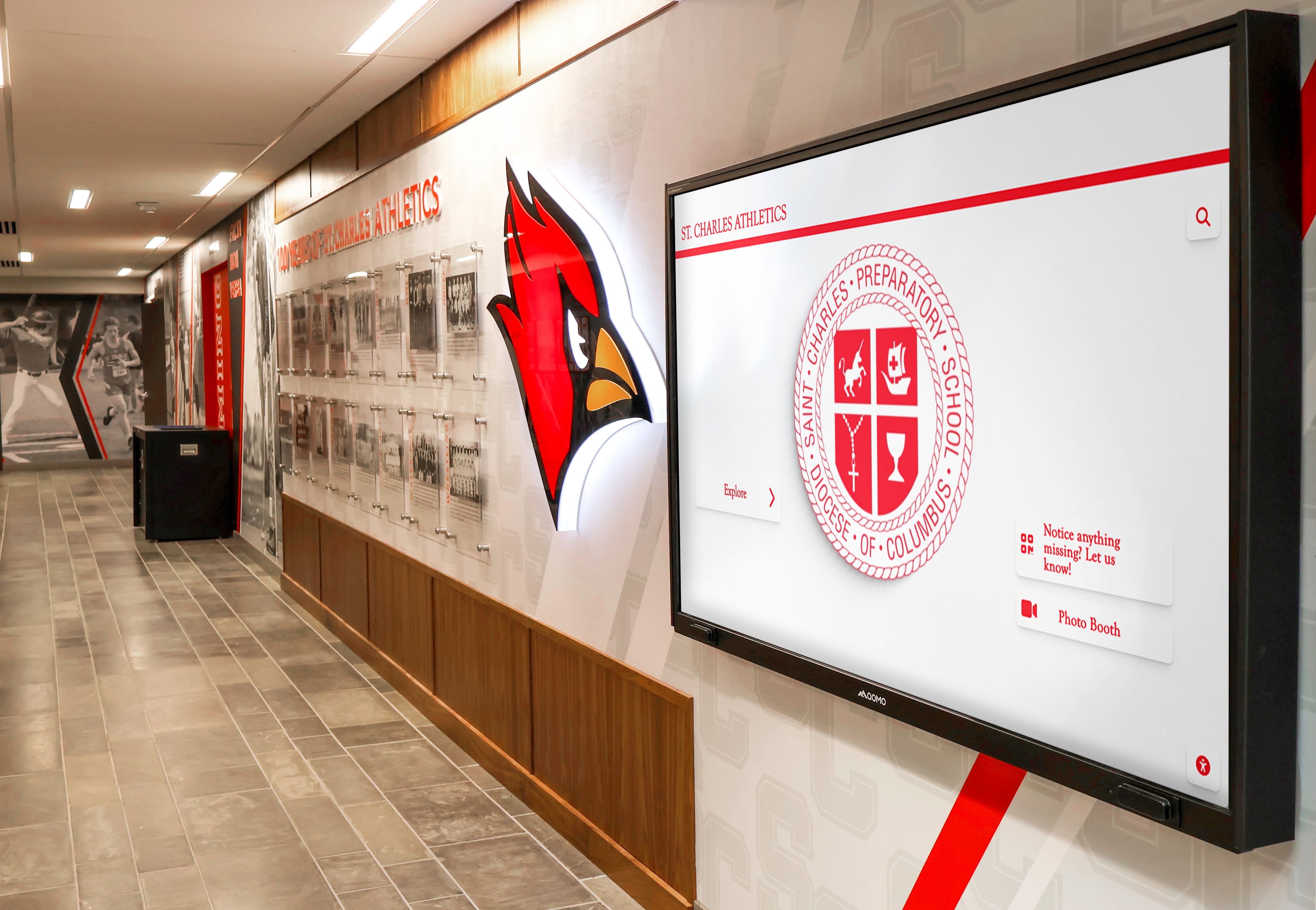
Real-Time Updates and Content Management
Cloud-based content management systems enable instant recognition updates without physical access to displays, transforming what previously required hours of labor into minutes of simple data entry.
Update Advantages:
Immediate Recognition:
- Add new records within minutes of achievement
- Update displays from anywhere with internet access—office computers, laptops, tablets, or smartphones
- No waiting for vinyl production, plaque engraving, or professional installation
- Changes appear instantly on displays after publishing
- Timely recognition while achievements remain fresh in community memory
- Mid-game updates possible for significant milestones
Simplified Management:
- Intuitive interfaces requiring no technical expertise
- Drag-and-drop photo and video uploads
- Template-based record entry ensuring consistency
- Bulk import capabilities for historical data
- Multi-user access with role-based permissions
- Version control tracking all changes
- Automated backups preventing data loss
- Preview modes showing exactly how content will appear
Administrative Efficiency:
- Updates that previously required 2-4 hours of physical labor complete in 15-30 minutes
- No travel to display locations required
- No materials costs (vinyl, mounting hardware, professional services)
- Single update across multiple displays when applicable
- Scheduled publishing for announcing recognition at specific dates/times
- Error corrections take minutes instead of requiring complete plaque replacements
Athletic department staff managing content report that ease of updates encourages more comprehensive recognition since adding content involves minimal effort. This accessibility ensures recognition stays current and complete.
Implementation Strategies for Basketball Records Recognition Programs
Successfully implementing basketball records recognition requires systematic planning addressing multiple considerations from goal-setting through ongoing operations.
Defining Recognition Goals and Scope
Begin with clear understanding of what the recognition program should achieve and what achievements deserve celebration.
Goal-Setting Questions:
- What primary purposes should recognition serve (motivation, tradition, recruitment, community engagement)?
- Which audiences are most important (current athletes, recruits, alumni, families, community members)?
- What time period should initial recognition cover (recent years, program history, specific eras)?
- Which achievement types deserve recognition (individual records, team accomplishments, academic success)?
- How will recognition integrate with other program initiatives (recruiting, fundraising, alumni relations)?
- What defines success for the recognition program (engagement metrics, behavioral outcomes, community feedback)?
- Should men’s and women’s programs receive equal recognition emphasis?
- Will recognition include sub-varsity levels (JV, freshman teams)?
Clear goal definition prevents scope creep while ensuring implementation addresses actual priorities rather than assumed needs.

Needs Assessment and Current State Analysis
Evaluate existing recognition approaches, available content, and technical infrastructure before finalizing implementation plans.
Assessment Components:
Current Recognition Inventory:
- Document all existing record displays, trophy cases, and physical recognition
- Photograph current displays for planning reference
- Identify which records are currently displayed versus stored or undocumented
- Assess physical display condition and remaining useful life
- Evaluate visitor engagement with current recognition through informal observation
Content Availability:
- Inventory available athlete photos, statistics, and biographical information
- Locate championship documentation and historical media coverage
- Identify media archives (local newspapers, yearbooks, program guides)
- Contact alumni associations about historical materials
- Assess coach and athletic staff knowledge about program history
- Evaluate whether video footage exists for recent seasons
- Review statistical record-keeping systems and data accuracy
Infrastructure Evaluation:
- Identify potential display locations with adequate space, visibility, and foot traffic
- Verify electrical power availability at desired locations
- Confirm internet connectivity (wired Ethernet preferred over WiFi)
- Assess lighting conditions that might affect screen visibility
- Consider environmental factors (temperature, moisture, direct sunlight)
- Evaluate mounting surface suitability for wall-mounted displays
- Review security considerations for valuable hardware
Location Selection and Display Placement
Display location fundamentally determines recognition program visibility and usage. Strategic placement ensures maximum impact on priority audiences.
Optimal Location Characteristics:
- High Traffic Areas: Spaces where target audiences naturally gather and pass regularly
- Appropriate Viewing Distance: Sufficient space for comfortable viewing and interaction (typically 8-15 feet for most displays)
- Symbolic Significance: Locations that reinforce importance of recognition within institutional culture
- Infrastructure Availability: Reliable power, network connectivity, and appropriate environmental conditions
- Accessibility: Locations accessible to all visitors including those with mobility limitations
- Security: Protected from vandalism while remaining publicly accessible
- Visibility During Events: Consideration of game-day and event traffic patterns
Common Successful Locations:
Gymnasium Lobbies: Primary entrances to gymnasiums ensure all athletes, families, and visitors encounter recognition displays. These high-visibility locations demonstrate institutional commitment to celebrating excellence.
Main School Entrances: Displays in primary school building lobbies demonstrate that athletic achievement matters to entire school communities, not just athletic departments. This placement reaches students not involved in athletics while welcoming all visitors.
Athletic Hallways: Dedicated corridors leading to locker rooms or practice facilities ensure current athletes see recognition daily, creating consistent motivational impact.
Alumni Centers or Visitor Areas: Locations specifically designed for alumni and guest reception provide natural fits for recognition displays, engaging returning graduates and prospective families.
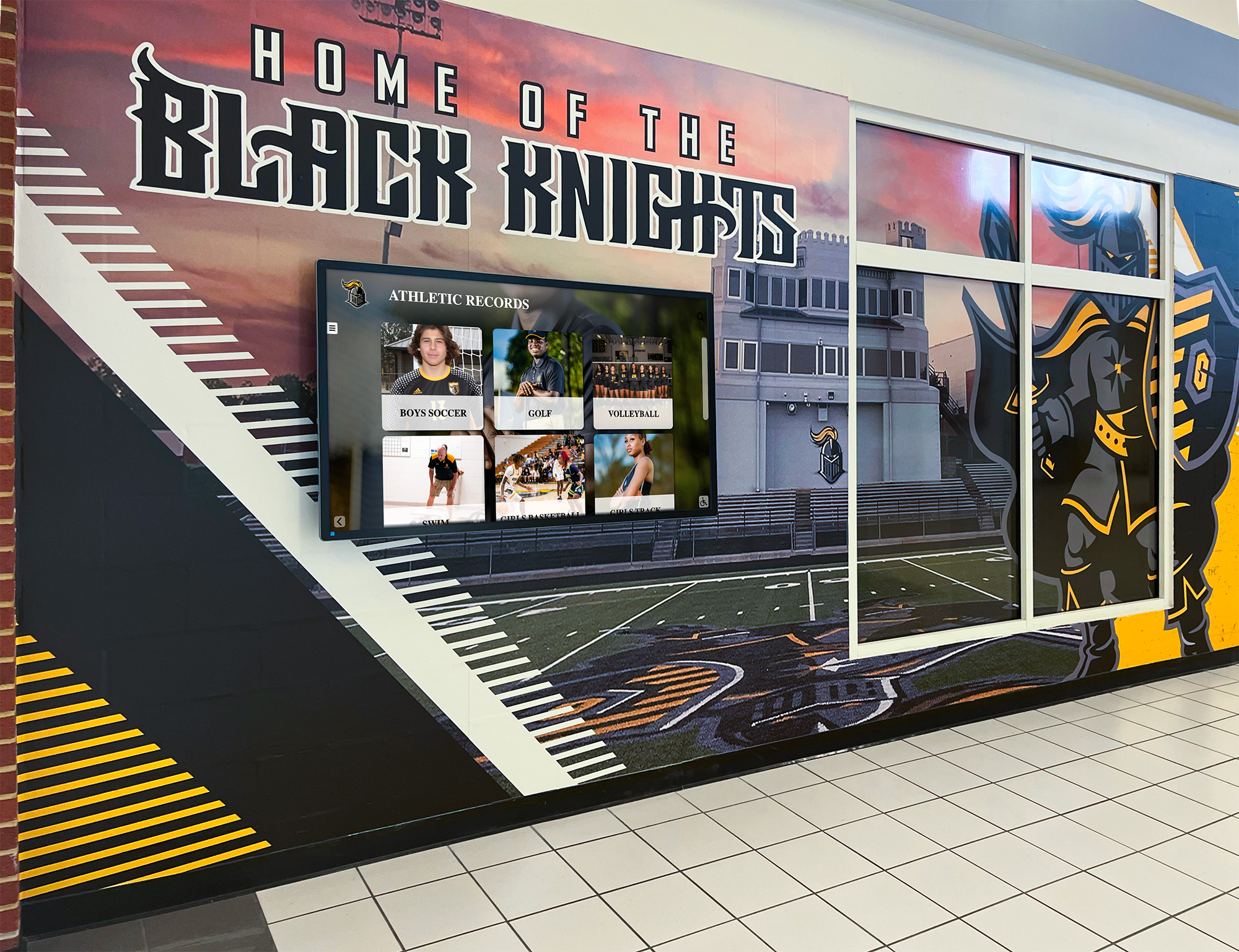
Hardware Selection and Screen Sizing
Matching display hardware to viewing conditions ensures comfortable interaction and appropriate visual impact.
Screen Size Guidelines:
43-55 Inch Displays:
- Suitable for intimate viewing (6-10 feet)
- Hallways or smaller lobby areas
- Individual or small group interaction
- Budget-conscious implementations
- Typical investment: $10,000-$15,000 complete system
55-75 Inch Displays:
- Standard gymnasium lobby installations (10-15 feet)
- Most common implementation size
- Balance between visibility and investment
- Accommodates both individual exploration and group viewing
- Typical investment: $15,000-$25,000 complete system
75-98 Inch Displays:
- Large gathering spaces (15-25+ feet)
- Major facility entrances or gymnasium concourses
- Maximum visual impact for signature installations
- Visible to crowds during events
- Typical investment: $25,000-$40,000 complete system
Hardware Quality Considerations:
Choose commercial-grade displays specifically designed for continuous operation rather than consumer televisions meant for residential use:
- Commercial specifications rated for 16-24 hour daily operation
- Hardened glass surfaces resisting impacts and vandalism
- Enhanced brightness (350-450 nits) for well-lit environments
- Minimal 3-year commercial warranties with rapid service
- Thermal management preventing overheating
- Proven reliability in institutional environments
- Professional-grade touchscreen technology (capacitive preferred)
Consumer displays typically fail within 18-24 months under school usage patterns. Commercial specifications deliver significantly lower total cost of ownership despite higher initial investment.
Content Development Planning
Recognition program success depends on compelling, accurate content that engages audiences while authentically honoring athletes.
Phased Content Development:
Phase 1 - Foundation Launch (Months 1-3): Focus initial development on:
- Current season rosters and statistics
- Recent 3-5 years of records and record holders
- All-time program records across major categories (scoring, rebounding, assists)
- Championship seasons with team photos and basic information
- Essential coach and program milestone recognition
- Minimum 70-80 athlete profiles with basic information and photos
- Core navigation structure and user interface design
Launch with substantial content creating strong first impressions rather than unveiling partially complete displays that disappoint early visitors.
Phase 2 - Enhancement (Months 4-8): Systematically enhance initial content:
- Extended athlete biographies with personal narratives and quotes
- Additional historical records expanding decade coverage
- Video highlights for recent athletes and memorable games
- Coach testimonials providing achievement context
- Alumni update features showing post-basketball success
- Historical photo galleries connecting program eras
- Academic achievement integration
- Target: 150-200+ athlete profiles with rich multimedia content
Phase 3 - Comprehensive Archives (Months 9-24): Build comprehensive historical recognition:
- Complete program history from founding forward
- Video interviews with coaching legends and notable alumni
- Documentary-style mini-profiles for most significant figures
- Detailed season-by-season documentation
- Comprehensive statistical databases with advanced metrics
- Cultural and tradition preservation stories
- Community impact features
- Target: 300-500+ profiles representing complete program history
Phased approaches enable timely launches with strong foundations while creating roadmaps for continuous enrichment maintaining long-term engagement.
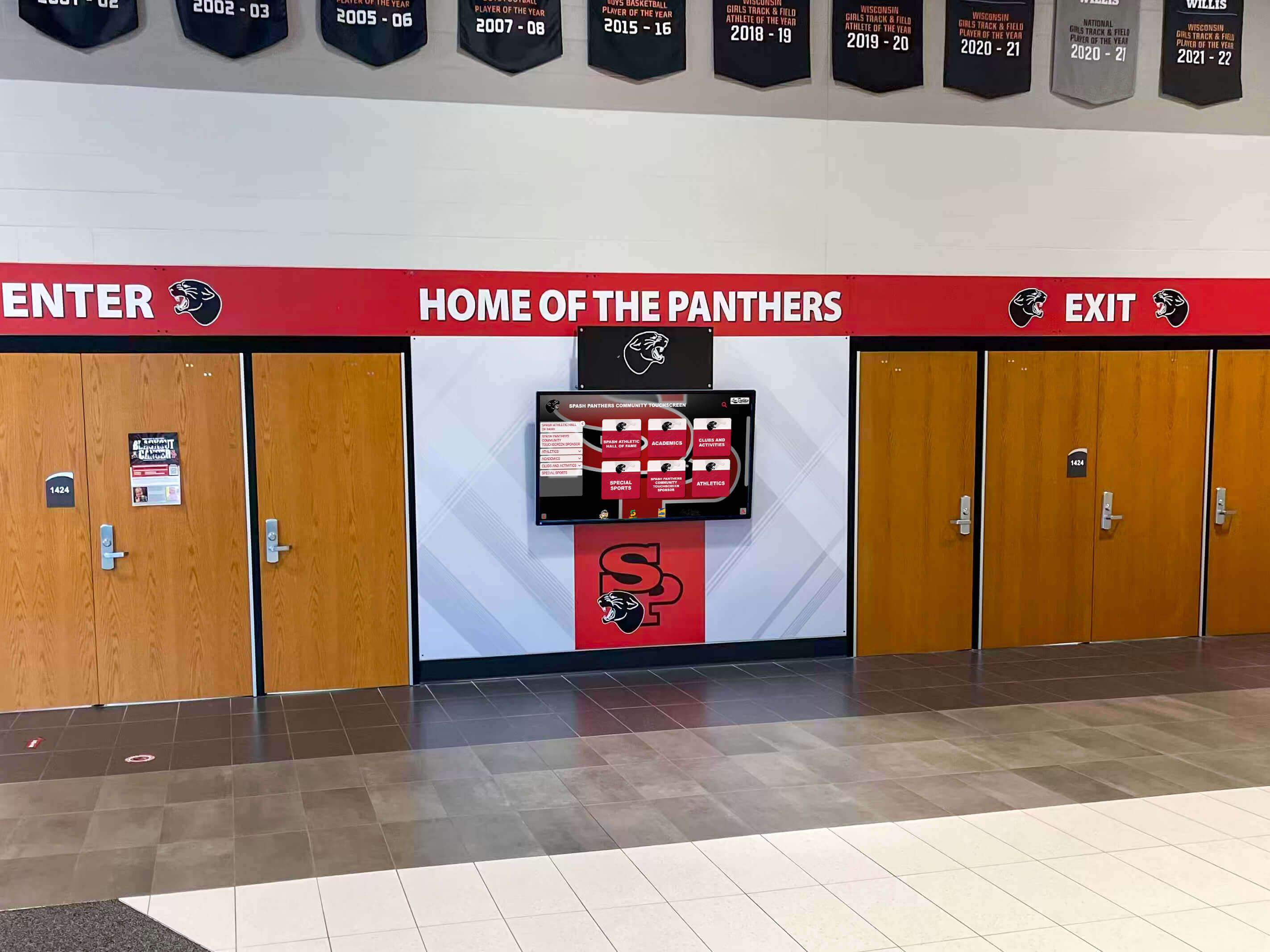
Budget Planning and Investment Considerations
Understanding investment requirements helps secure necessary funding and plan implementations matching available resources.
Implementation Cost Components:
Initial Investment ($10,000-$40,000):
Hardware ($5,000-$20,000):
- Commercial-grade touchscreen display
- Industrial computing module
- Mounting system (wall bracket or freestanding kiosk)
- Cabling and connectivity infrastructure
- Protective elements if needed
- Installation labor and configuration
Software ($2,000-$5,000 first year):
- Content management platform licensing
- Interactive touchscreen software
- Design customization and branding integration
- Initial training and technical support
- Setup and configuration services
Content Development ($3,000-$15,000):
- Historical research and data compilation
- Professional photography of athletes and action shots
- Video production for highlights and interviews
- Writing and editing biographical content
- Digitization of existing materials (photos, documents, records)
- Initial content database population
- Graphic design for custom layouts
Annual Operating Costs ($2,000-$6,000):
- Software licensing and support ($1,500-$3,000)
- Ongoing content updates and additions ($500-$2,000)
- Hardware warranty extensions beyond standard coverage ($500-$1,000)
- Periodic professional content development assistance (optional)
Return on Investment:
Digital recognition systems deliver value justifying investment through:
- Eliminated Material Costs: Traditional boards require $2,000-$5,000 annually for updates
- Reduced Labor: Digital updates taking 30 minutes replace physical updates requiring 2-4 hours
- Enhanced Engagement: 6-8x higher visitor interaction increases recognition effectiveness
- Recruitment Impact: Visible recognition influences prospect decisions positively
- Space Efficiency: Single display consolidates recognition requiring 100+ feet of physical wall space
- Longevity: Commercial displays lasting 5-7+ years versus traditional materials requiring replacement every 3-5 years
- Alumni Engagement: Digital platforms strengthen connections leading to increased giving
Most programs calculate break-even within 3-4 years based purely on eliminated update costs, with ongoing strategic value substantially exceeding traditional approaches.
Funding Sources:
Schools successfully fund recognition programs through:
- Athletic department operating budgets
- Basketball booster club campaigns
- Alumni association support and memorial giving
- Corporate sponsorships from local businesses
- Naming opportunities for major donors ($5,000-$25,000 recognition levels)
- Crowdfunding campaigns engaging broader communities
- Grant applications to foundations supporting educational technology
- Fundraising events tied to basketball season (tip-off dinners, alumni games)
Best Practices for Basketball Records Recognition
Successful programs implement recognition following proven approaches maximizing impact while maintaining authenticity and engagement.
Comprehensive Recognition Across Achievement Types
Effective programs recognize diverse contribution forms rather than focusing exclusively on scoring leaders or starting players.
Recognition Diversity:
- Statistical excellence across all categories (scoring, rebounding, assists, steals, blocks)
- Character and leadership awards
- Academic achievement alongside athletic success
- Practice players and development contributors
- Multi-year consistency and dedication
- Improvement awards showing significant development
- Team chemistry and culture builders
- Community service and off-court contributions
This comprehensive approach ensures all valuable contributions receive appropriate acknowledgment, preventing recognition programs from feeling exclusive to statistical superstars.

Balancing Individual and Team Recognition
Basketball’s nature as both an individual and team sport requires balancing personal achievement acknowledgment with team success celebration.
Balance Strategies:
- Position team awards and championships as highest program honors
- Connect individual records to team success context
- Recognize that statistics often reflect quality teammates, coaching, and circumstances
- Feature championship seasons comprehensively alongside individual records
- Create recognition categories emphasizing team contributions
- Highlight assist leaders and defensive specialists equally with scorers
- Celebrate selfless plays and winning contributions beyond statistics
This balanced approach prevents individual statistics from overshadowing collective achievements while still honoring exceptional personal performance.
Maintaining Authenticity and Meaningful Standards
Recognition loses impact when it feels like participation awards distributed regardless of actual achievement. Maintain authentic standards while finding ways to acknowledge diverse contributions.
Authenticity Principles:
- Clear Criteria: Establish objective standards for what earns recognition
- Selective Prestige: Reserve highest honors for truly exceptional achievement
- Effort Recognition: Create categories honoring improvement and dedication even without statistical prominence
- Consistency: Apply recognition criteria equally across all athletes and eras
- Honest Context: Provide accurate context about achievements rather than exaggerating significance
- Historical Accuracy: Verify records through multiple sources when possible
- Correction Protocol: Establish processes for addressing errors discovered in historical records
Regular Updates and Content Freshness
Static content causes engagement to decline rapidly. Regular updates maintain interest and give visitors reasons to return repeatedly.
Update Schedule:
- Weekly During Season: Feature current week’s outstanding performances and updated statistics
- Post-Game: Highlight notable individual achievements from recent games
- Monthly: Rotate featured athletes and historical content to maintain variety
- Seasonally: Update current season statistics and tournament progressions
- Annually: Add new graduating seniors and season-ending records
- Ongoing: Enhance existing profiles with additional multimedia content as it becomes available
- Historical Research: Systematically add historical content filling program gaps
Students who see identical featured content week after week stop checking for updates. Regular refresh communicates that recognition is current, ongoing, and comprehensive rather than historical and complete.
Promotion and Awareness Building
Even excellent recognition displays require ongoing promotion ensuring target audiences discover and engage with them.
Promotion Strategies:
Launch Phase:
- School-wide announcements introducing the recognition system
- Demonstrations during athletic banquets and basketball games
- Parent communication through newsletters and social media
- Local media coverage of installation and featured athletes
- Grand opening ceremony featuring highlighted players and alumni
- Student assembly showcasing the new system
Ongoing Promotion:
- Regular announcements about newly added records and achievements
- Integration into campus tours for prospective families
- Social media campaigns featuring profiles and milestones
- Event-driven features during homecoming, senior nights, championships
- Competitions encouraging exploration (scavenger hunts, trivia contests)
- Coach references during team meetings and motivation
- Inclusion in game programs and promotional materials
Measuring Basketball Records Recognition Program Success
Evaluating recognition program effectiveness helps justify continued investment and identifies improvement opportunities.
Quantitative Engagement Metrics
Digital recognition systems provide valuable analytics revealing how audiences interact with content.
Key Metrics to Track:
- Total visitor sessions (daily, weekly, monthly, annually)
- Average interaction duration per session (target: 4-8 minutes for basketball displays)
- Screens viewed per session indicating exploration depth
- Most-viewed athlete profiles revealing what resonates
- Search queries showing what information visitors seek
- Peak usage times identifying when engagement occurs (game days, after school, etc.)
- Repeat visitor percentages showing sustained interest
- Mobile/web access statistics for remote engagement
- Video view completion rates
This data informs content development priorities, demonstrates return on investment, and reveals what content types generate greatest engagement.
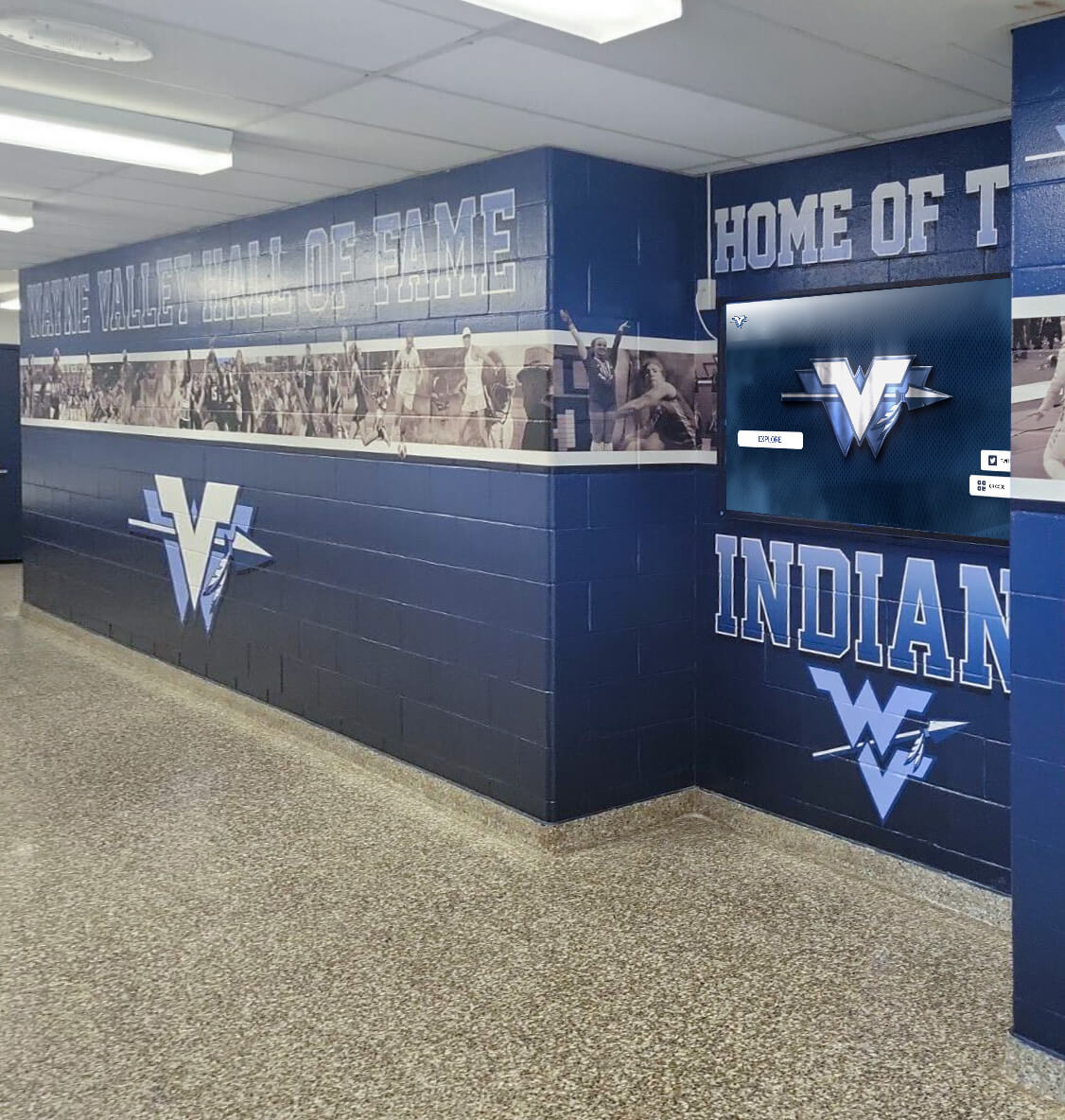
Qualitative Impact Assessment
Numbers tell partial stories. Qualitative feedback provides deeper understanding of recognition program influence.
Qualitative Research Methods:
Player Surveys:
- How does recognition influence motivation and effort?
- Do players feel their contributions are meaningfully acknowledged?
- Does visible tradition and history impact their program experience?
- What improvements would enhance recognition effectiveness?
- Does recognition affect goals and aspirations?
Coach Observations:
- How do recognition tools help motivate and develop players?
- What behavioral changes correlate with recognition program implementation?
- How does recognition affect program culture and team unity?
- What competitive positioning advantages does recognition provide?
- Impact on practice intensity and attention to skill development
Family Feedback:
- Does recognition meet expectations compared to other programs?
- How does athlete recognition influence family satisfaction with program?
- What aspects of recognition create greatest impact?
- Would families recommend program based partially on recognition approach?
Alumni Engagement:
- Has recognition strengthened alumni connection to program?
- Do alumni visit displays when returning to campus?
- Does recognition influence alumni giving or volunteer involvement?
- What improvements would enhance alumni experience?
Program Outcomes and Strategic Impact
Beyond direct engagement, evaluate whether recognition contributes to broader program objectives.
Outcome Metrics:
- Participation Trends: Year-over-year changes in roster sizes and tryout attendance
- Retention Rates: Player continuation from freshman through senior years
- Performance Indicators: Win-loss records, playoff qualification, championships
- Recruitment Success: Prospect commitment rates and incoming athlete quality
- Academic Achievement: Team GPA trends and academic award rates
- Alumni Engagement: Event attendance, giving participation, volunteer involvement
- Community Support: Game attendance, booster membership, fundraising success
- Social Media Growth: Followers, engagement, and reach of program content
While not all changes result solely from recognition programs, consistent positive trends following implementation suggest recognition contributes to desired outcomes.
Advanced Features and Future Capabilities
Leading basketball records recognition systems incorporate advanced features enhancing user experience and administrative efficiency.
Mobile and Web Access
Extending recognition beyond physical displays multiplies impact and accessibility.
Mobile Integration Benefits:
- Athletes can share their profiles with family, friends, and college coaches
- Alumni access recognition from anywhere in the world
- Prospective recruits explore program achievements before campus visits
- Parents follow athlete accomplishments throughout seasons
- Media access statistics and information for coverage
- Integration with social media platforms for easy sharing
Live Statistics Integration
Advanced systems can integrate with scorekeeping software for dynamic updates.
Real-Time Features:
- Career statistics update automatically after each game
- Milestone alerts when athletes approach records
- Live leaderboards showing current season standings
- Automatic notifications to coaches and administrators
- Social media integration for instant celebration announcements
Artificial Intelligence Enhancements
Emerging AI technologies will increasingly enhance recognition systems.
AI Applications:
- Automated highlight video generation from game footage
- Intelligent content recommendations based on visitor behavior
- Natural language search enabling conversational queries
- Content gap identification suggesting needed additions
- Predictive analytics forecasting when athletes might reach milestones
- Automated photo organization and tagging

Special Considerations for Basketball Recognition
Basketball programs have unique characteristics requiring specific recognition considerations.
Gender Equity in Recognition
Title IX and general equity principles require equal recognition for men’s and women’s basketball programs.
Equity Guidelines:
- Provide equal display space or prominence for both programs
- Apply identical recognition standards and categories
- Ensure equivalent multimedia content development
- Feature both programs equally in promotional materials
- Allocate update resources fairly between programs
- Consider integrated displays showing both programs together
- Maintain separate statistical records reflecting different game characteristics
Historical Era Adjustments
Basketball has evolved significantly over decades, requiring thoughtful context when comparing achievements across eras.
Era Considerations:
- Note rule changes affecting statistics (three-point line adoption, shot clock changes)
- Acknowledge schedule length differences (20-game vs. 30-game seasons)
- Consider competition level changes as programs improved
- Provide context about playing style evolution
- Use era-adjusted statistics when comparing across decades
- Feature decade-by-decade leaders alongside all-time records
Multi-Level Program Recognition
Comprehensive programs include varsity, junior varsity, and freshman teams appropriately.
Multi-Level Strategies:
- Create separate record categories for each level when appropriate
- Feature varsity prominently while including sub-varsity achievements
- Track athlete progression across levels over their careers
- Recognize that JV/freshman records inspire younger athletes
- Document complete player development journeys
- Consider space allocation reflecting competitive level importance
Case Study Insights and Implementation Lessons
Schools successfully implementing basketball records recognition follow patterns that maximize value and minimize challenges.
Small School Success Stories
Small schools (300-700 students) often question whether digital recognition makes sense for smaller basketball programs. Implementation experiences demonstrate value scales to all program sizes.
Small School Benefits:
- Unlimited capacity finally allows showcasing complete program history
- Recognition across all sports receives equal treatment
- Professional presentation creates outsized impact on program perception
- Easy updates particularly valuable where coaching staffs are smaller
- Community engagement intensifies in tight-knit environments
- Alumni connections strengthen through visible honoring of all graduates
Small schools report that digital recognition becomes signature elements of athletic facilities, creating impact disproportionate to investment.
Large Program Comprehensive Systems
Large schools (1,500+ students) with extensive basketball programs face different challenges—massive record volumes across decades, both men’s and women’s programs, and complex administrative structures.
Large Program Strategies:
- Implement multiple displays for different locations
- Create extensive content libraries with hundreds of athlete profiles
- Develop sophisticated categorization and search systems
- Establish dedicated staff roles for content management
- Integrate with athletic department databases and systems
- Create comprehensive historical archives through systematic research
Large schools often implement networks of displays—main gymnasium for current recognition, hallways for historical content, practice facilities for motivational displays—all managed through centralized systems.

Conclusion: Honoring Basketball Excellence Through Modern Recognition
Basketball records recognition transforms how schools celebrate athletic achievement—moving from outdated physical boards that frustrate updates and limit capacity to dynamic digital experiences that inspire exploration, build pride, and motivate excellence. Modern recognition technology addresses every limitation of traditional approaches while creating new possibilities for honoring achievement with depth, accessibility, and engagement that contemporary students expect and deserve.
Successful implementation requires more than purchasing equipment—it demands strategic planning, compelling content development, thoughtful design, sustained promotion, and ongoing commitment to maintaining relevance. Schools approaching basketball records recognition systematically, learning from proven best practices, create programs delivering value far exceeding investment through enhanced motivation, stronger culture, improved recruitment, and preserved legacy.
Basketball players achieve remarkable things worthy of celebration—breaking records, winning championships, demonstrating dedication and character that shape their lives. Comprehensive basketball records recognition ensures these achievements receive acknowledgment matching their significance, creating experiences that honor the past, celebrate the present, and inspire future excellence.
The athletes who dedicate countless hours to developing their skills, representing their schools with pride, and building program traditions deserve recognition that doesn’t fade when ceremonies end or gather dust in forgotten trophy cases. They deserve recognition that inspires for generations, strengthens communities, and preserves legacies permanently.
Ready to transform basketball records recognition at your institution? Rocket Alumni Solutions provides comprehensive platforms designed specifically for schools and athletic programs, combining intuitive content management, engaging user experiences, and dedicated support ensuring long-term success. Every record tells a story about dedication, achievement, and excellence—modern recognition systems help you tell those stories in ways that truly inspire.




































